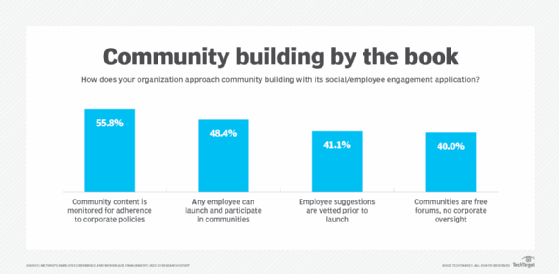
Getty Images/iStockphoto
How to approach enterprise social software for hybrid work
Enterprise social software can help organizations build communities to support employee engagement in the hybrid workplace. But IT leaders need to weigh how to manage communities.
Working toward creating an engaged workforce and a connected culture is certainly not a trend endemic to the hybrid work model that's arisen out of the COVID-19 pandemic. But hybrid work does make the mission all the more important.
Working from home, even if only a couple days a week, can be isolating. Mixing and matching at-home and in-office hours during the week can be challenging. Only seeing team members or other key collaborators while working in a minimally populated office can lead to a feeling of disconnectedness with the company as a whole. Used effectively, enterprise social software can diminish the impact of these and other hybrid work challenges by building community and spurring engagement among employees.
Companies that are serious about optimizing employee engagement should have enterprise social software on their short list of employee experience technologies to implement. Some IT leaders may be tempted to think, "We don't need social software. We've got our intranet for that or our team chat app does the job." And, while it's true there is some overlap among these different types of tools, social software shines in its ability to bring together any type of employee -- from C-suite officers to the frontline workers -- for conversation on topics of mutual interest.
The possibilities for forging bonds and a sense of belonging are limitless when using social software, with the ability to create communities around interests and topics, such as women in tech, single parents, labradoodle lovers and science fiction enthusiasts. Employees are no longer just talking with their same old team members, but rather meeting and engaging with all sorts of new people across the company.
Standalone vs. integrated social software
Social software is used by 45% of companies, according to Metrigy's "Employee Experience & Workplace Engagement: 2022-23" global research study of 250 companies. Another 36.3% have social software on their 2022 or 2023 roadmaps, making it one of the top three growth opportunities in employee experience technology. Additionally, 13.5% of organizations are evaluating social software.
Social software is available as a standalone app or integrated as part of an employee experience platform. One of the latest integrated offerings comes from Microsoft, which, in July, introduced Viva Engage, an app for its Viva employee experience platform. Meanwhile, Microsoft's long-available social software Yammer is offered as a web and mobile app. Other social capabilities are available in platforms such as LumApps and Workplace from Meta, while MixR is an example of a standalone community building app.
One important consideration when evaluating social software is integration into employees' collaboration apps. For example, Viva Engage will integrate with Microsoft Teams, as Workplace from Meta is. This enables employees to remain in the apps they use for team chats and meetings to also engage in their communities of interest.
Management considerations for social communities
Beyond the technology itself, companies must think about how loose or rigid they'll be in monitoring and managing these community forums. On the one hand, for true engagement and connectedness with a company, employees should be able to build communities around topics of interest to them and speak freely about what's on their minds. On the other hand, many leaders feel they need to make sure employees are abiding by company policies regarding behavior toward others.
The following are key questions to ask before implementing enterprise social software:
- Who can launch and participate in communities? In Metrigy's employee experience study, 48.4% of companies said any employee can do either.
- Will we vet ideas or let employees spin up communities as they like? Slightly more than 41% of companies put ideas through an approvals process.
- Once launched, will we monitor communities for adherence to corporate policies? Nearly 56% of companies monitor community content.

About 40% of companies consider communities built using social software to be free forums. They have no corporate oversight in place. If this is not a stance your company is comfortable taking, then a light touch is advised. Besides driving engagement and creating connectedness, communities that encourage open and frank conversations help build trust -- not only from one employee to another, but with the company as a whole.








